There are two young adults standing in the central court of NGV International: a girl texting and, a small distance away, a boy with hands in pockets. They’re 12-foot tall and they’re black, and they’re on display as part of the third edition of NGV Triennial: the National Gallery of Victoria’s behemoth exhibition of contemporary international art and design, which opened on Sunday.
These titans, the work of UK sculptor Thomas J Price, are a distinctive choice for this central position. While they’re impossible to miss, they lack the spectacle of the colossal reclining Buddha (by Chinese artist Xu Zhen) that occupied this central spot for the inaugural Triennial in 2017, and the supersized swirling digital display (by Turkish-American artist Refik Anadol) in 2020. By contrast, Price’s statues feel anti-monumental; quotidian. They pose the questions: What is worthy of size? What takes up space – in public and in museums? How do these Big Important Things make us feel, as viewers? Is bigger actually better?
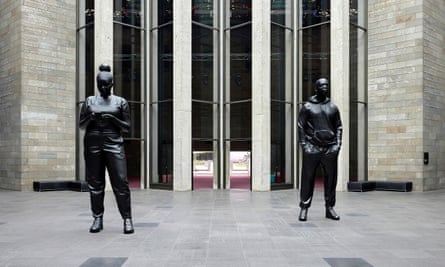
The moment feels emblematic of this latest edition of Triennial, and the show’s shifting nature over nine years. Having proved itself with record audience numbers, and cemented itself as a major event in the national art calendar, the Triennial – which is free to enter – can perhaps now try a little less hard; be more tangential, and playful.
There’s a sense of cheeky provocation in the giant thumbs up sculpture by UK satirist David Shrigley at the gallery’s street entrance, and in the two banners hanging over the building’s entrance: one features a photo of art prankster Maurizio Cattelan’s notorious banana work, the other a photo of UK artist Ryan Gander’s precocious animatronic mouse, its head poking through a tiny hole in the wall. (NGV doubles down on Catellan’s prank by giving the banana its own white-cube space; Gander’s talking mouse occupies an appropriately antiheroic corridor position.)
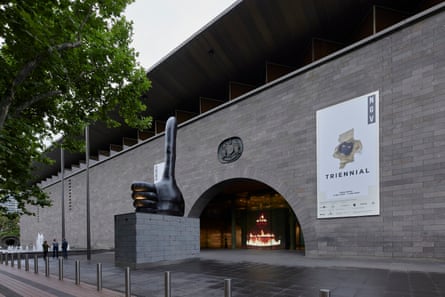
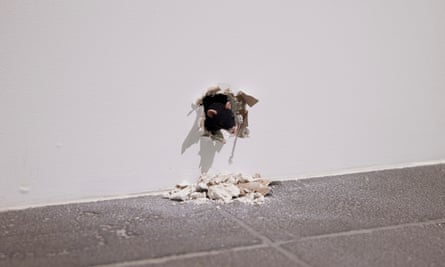
That’s not to say this year’s Triennial is not a Big Important Show. The numbers alone are overwhelming – almost 100 works or projects by more than 120 artists, designers and collectives, spread over the gallery’s three levels – before you even try to wrap your eyes and brain around the exhibition. (Do not, under any circumstances, attempt to “do the Triennial” in one visit.)
There are show-stopper moments and plenty of famous names: a text-based work by Yoko Ono on the north facade of the building and a participatory installation about mothers inside, a suite of freshly acquired works by Tracey Emin, and a collection of fantastical looks and accessories by Maison Schiaparelli. This year’s Instagram fodder will include Sheila Hicks’s giant blue yarn-like balls (the soft antidote to Ron Mueck’s giant skulls, of 2017) and Swiss artist Franziska Furter’s “weather room”: a hypercolour carpet depicting infrared satellite images of hurricanes, overhung with delicate strands of transparent glass beading that look like rain.
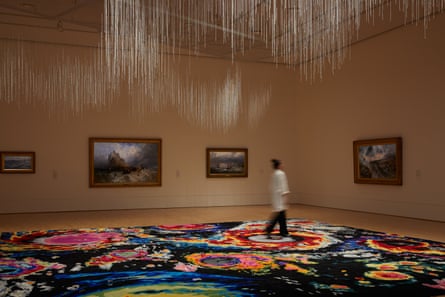
But the placement of Price’s figures, at the centre of the Triennial, seems to represent shifting priorities, and the gallery’s responsiveness to worldwide conversations about representation in museum spaces – and specifically, black visibility.
This is backed up by a fulsome strand of excellent art by black artists, including works by US photographer Tyler Mitchell (who shot to fame aged just 23 for his history-making Vogue cover shot of Beyoncé) that “reclaim small moments everyday joy”; and two works by New York-based artist Derek Fordjour (also a favourite of Beyoncé), including his tour-de-force video work Fly Away made with puppeteer Nick Lehane, in which the puppet figure of a young black man attempts to not only survive but thrive while being manipulated by four white (and human) puppeteers.

Textile works also get hero placement in this year’s edition, reflecting a resurgence in the art form. Besides the Sheila Hicks work, a massive room on the ground floor is given over to Mun-dirra: a labyrinthine installation comprised of 10 large panels of woven pandanus that were created over two years by 13 women from the Burarra language group in western Arnhem Land, drawing on customary techniques used to make fish fence traps. Perambulating the channels of this installation, inhaling the grassy smell of the dried pandanus, I was transported; in a daydream moment, I imagined I was a fish.
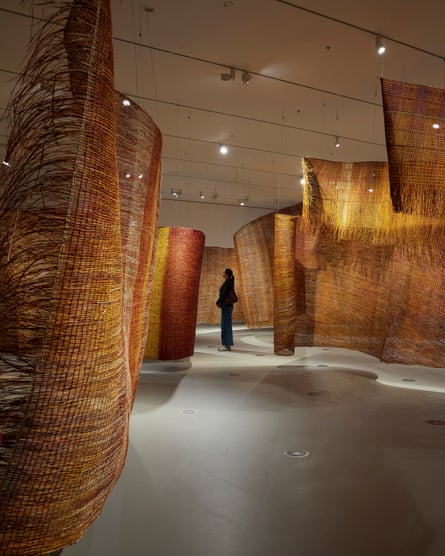
Another standout among the major textile commissions is the epic, 40-metre-long narrative tapestry Conflict Avocados, by Mexican designer Fernando Laposse, which renders a remarkable real-life tale of environmental degradation, human exploitation and Indigenous resistance in disarmingly soft pastel tones, using pigments concocted from avocado pips and marigold flowers.

There are powerful smaller-scale works, too: losing my way in the rabbit-warren collection galleries of the second floor, I suddenly find myself face to face with a striking symbolist tapestry by US artist Diedrick Brackens, woven from hand-dyed cottons and featuring a black figure kneeling on a stark red earth, a strand of chain held between his upheld fists.
Painting is also out in force within this edition, from senior APY artists Iluwanti Ken and Betty Muffler to mid-career Melbourne painter Prudence Flint and Tehran’s Farrokh Mahdavi. There’s a preponderance of works by so-called “ultra-contemporary” artists (born after 1975), including British art-market stars Lucy Bull and Flora Yukhnovich, New York-based painters Chase Hall and Ilana Savdie, and Czech artist Vojtěch Kovařík.
after newsletter promotion
Among overstuffed gallery spaces where things often jostle for the viewer’s attention, these paintings are often elevated by their presentation: Yukhnovich’s luminous work is juxtaposed with examples of the Dutch floral still life and French Rococo paintings that inspired it; Flint’s suite of uncanny domestic portraits is given a custom-carpeted nook of its own, and placed alongside striking 16th and 17th-century portraits of women by Flemish masters, a style that has informed her practice.
Among several impressive whole-room presentations, including installations by Japanese floral artist Azuma Makoto and Kosovan artist Petrit Halilaj, one of the most gorgeous is devoted to a suite of large, jewel-toned paintings by Melbourne-based artist Richard Lewer, depicting the biblical story of Adam and Eve. Within the darkened space, two sets of six paintings face each other from opposing walls, while the adjacent wall features a breathtaking 16th-century altarpiece painting of the Passion of Christ. At the centre of the room, two church pews have been placed back to back, for quiet contemplation.
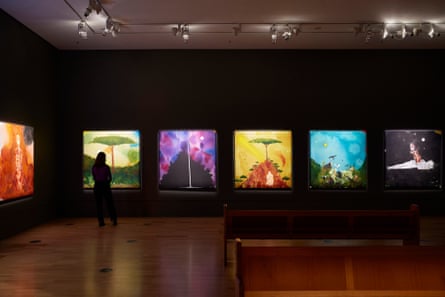

As in previous editions of the Triennial, these moments when old and new art are smashed together are some of the most magical, with each work producing strange, thrilling vibrations in the other. New York artist Diana al-Hadid takes top honours with two major new sculptural displays inspired by (and incorporating) ancient and medieval objects and artworks from the NGV collection – including two knockout Renaissance paintings.
Laced with gold, dramatically lit and set within a figure-of-eight-shaped gallery space lined in dramatic black velvet, it’s a coup de théâtre moment.

Many of the Triennial’s weakest moments, similarly, come down to design and presentation. While many of the contemporary works are successfully incorporated into collection displays to revelatory effect (within the Chinese and South Asian collections, for example), there are a number of placements that feel baffling, even detrimental. Italian artist Diego Cibelli’s dramatic white sculpture of a throne made from fruit and vegetables feels lost at sea among impressionist landscape paintings and 19th-century portraits. Almost all the contemporary works installed in the much-loved, densely-hung Salon room feel overwhelmed (and consequently, underwhelming), including carved tree scenes by Natsiaa-winning Aurukun artist Keith Wikmunea and Vernon Marbendinar that rightfully should pop.
Next door, an exhilarating hang of vibrant canvases by Guatemala-based artist Vivian Suter threatens to overpower three striking but comparatively understated black-and-white paintings by Pitjantjatjara artist Timo Hogan, with no apparent logic behind the juxtaposition – a feeling compounded by the inclusion in the same room of a 19th-century English landscape by Constable and an 18th-century seapiece by Thomas Gainsborough.
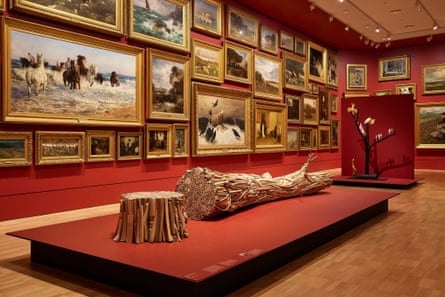
In an exhibition this large, which represents a vast spectrum of art forms and aesthetics within a comparatively limited space, not every work can be presented to best effect. Inevitably, some will shine and others will not. Having spent hours navigating the labyrinthine NGV galleries to locate every work, my sense was that less art might mean more impact. Maybe bigger is not, in fact, better.
That said, you would be hard pressed to spend even 20 minutes exploring this Triennial and not be rewarded; with this much work, selected with love and attention by the NGV’s entire curatorial staff, finding great art is like shooting fish in a barrel. You simply cannot miss.
The NGV Triennial is free entry and open in Melbourne until 7 April 2024. Click here for the full program of art and events
This article was corrected on Tuesday 5 December. The original version incorrectly stated Thomas J. Price’s sculptures were of teenagers; they are of young adults
